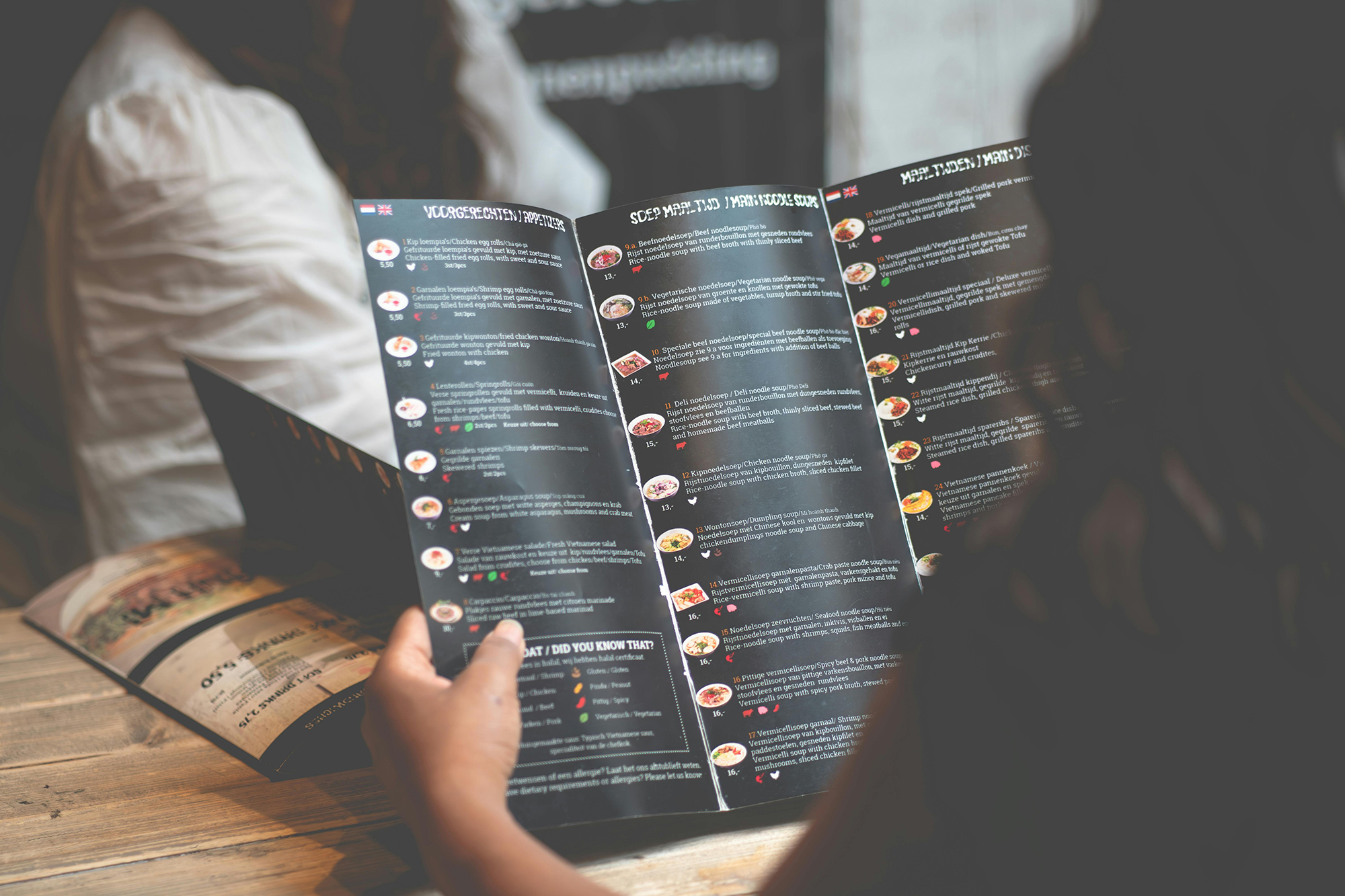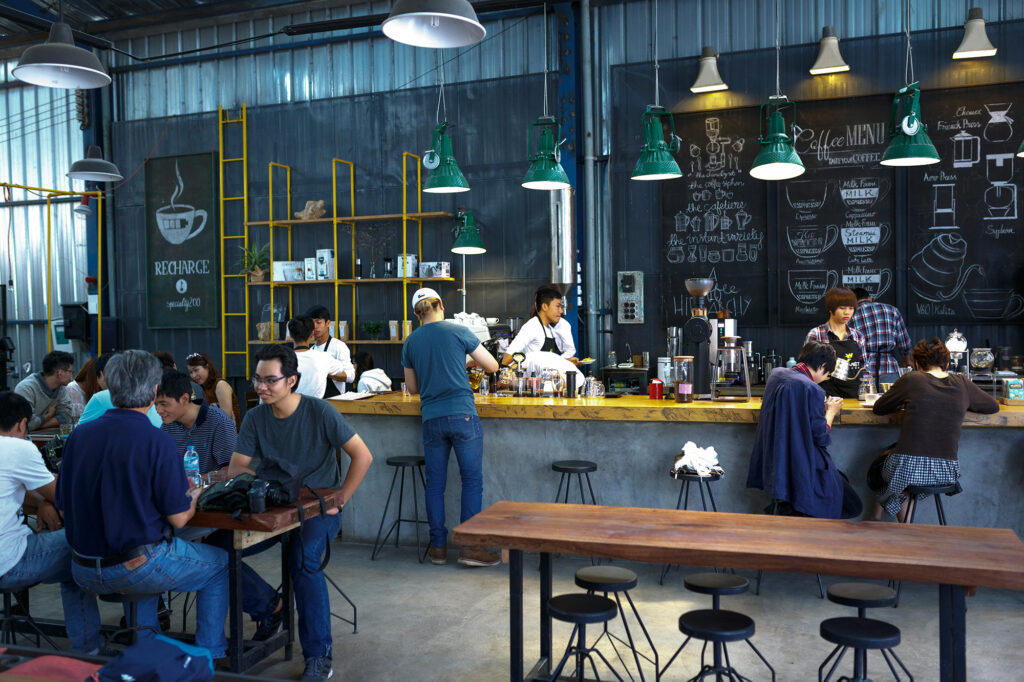In the highly competitive food and beverage (F&B) industry, a menu is more than just a list of dishes—it’s a powerful marketing tool that can significantly influence consumer choices and spending behaviour. A thoughtfully designed menu guides customers through their dining decisions, enhances their experience, and ultimately boosts your profits. By leveraging the psychology behind menu design, restaurants can strategically shape customer behaviour, leading to increased satisfaction and profitability.
The Role of Menu Design in Influencing Customer Choices
Menu design plays a crucial role in shaping how customers interact with your offerings. It goes beyond aesthetics; effective menu design uses psychological principles to guide customer decisions, highlighting profitable items and creating a seamless dining experience. When executed well, it can lead to higher average spend per customer and improved customer satisfaction.
Key Psychological Factors Influencing Menu Choices
1. Item Placement: The “Golden Triangle”
Strategic item placement on the menu can direct customers’ attention to specific dishes. The “Golden Triangle” refers to the areas where customers’ eyes naturally fall first—typically the top right and centre sections of the menu. These spots are prime real estate for placing high-margin or signature items that you want to promote, ensuring they capture the most attention.
2. Descriptive Language
Using vivid, sensory-rich descriptions can elevate the perceived value of a dish, making it more appealing and justifying a higher price. For example, “Juicy, Herb-Marinated Chicken Breast with Sun-Dried Tomato Pesto” sounds more enticing than just “Grilled Chicken.” This technique not only enhances customer perception but also influences their decision-making process, encouraging them to choose higher-priced items.
3. Price Presentation
How prices are presented can subtly affect spending behaviour. For instance, removing currency symbols (e.g., displaying “12” instead of “£12”) can reduce the focus on cost, making customers less price-sensitive. Additionally, using rounded numbers (e.g., “10” instead of “9.99”) can convey quality and make prices appear less transactional.
Principles for Effective Menu Design
Designing an effective menu involves more than just listing items. It requires incorporating principles that enhance readability, highlight profitable choices, and simplify decision-making. Here are some key strategies:
1. Strategic Item Placement
Position your high-margin dishes in the top right and centre sections of your menu, where customers’ eyes naturally go first. Studies show that customers often read menus in a Z-pattern, so placing profitable items in these zones increases the likelihood of them being ordered.
2. Use of Descriptive Language
Leverage descriptive language to paint a picture of your dishes. Highlighting ingredients, cooking methods, and unique qualities can transform a simple dish into an irresistible choice. For instance, instead of “Pasta,” try “Creamy Alfredo Pasta with Freshly Grated Parmesan and Truffle Oil.” This not only makes the dish more appealing but also justifies a premium price.
3. Visual Design Elements
Visual elements such as fonts, colours, and spacing can significantly influence how customers interact with your menu. Use clear, readable fonts and highlight key items with bold text, boxes, or contrasting colours. Avoid clutter to prevent decision fatigue and create a visually pleasing experience.
4. Price Presentation
Experiment with different price formats to see what resonates with your customers. For example, removing currency symbols or using rounded numbers can make prices feel less like a financial transaction and more like part of the dining experience.
5. Decoy Pricing
Introduce a higher-priced option to make other items appear more reasonably priced. For example, featuring a premium wine on your list can make mid-range options seem like better value, steering customers towards those selections.
Practical Tips for Optimising Your Menu Design
Even minor adjustments to your menu design can have a significant impact on customer behaviour and profitability. Here are some practical tips to help you make the most of your menu:
1. Highlight High-Margin Items
Identify your most profitable dishes and ensure they stand out on the menu. Use visual cues like boxes, bold fonts, or highlighted backgrounds to draw attention to these items. This strategy subtly guides customers towards ordering high-margin dishes, boosting overall profitability.
2. Enhance Dish Descriptions
Rework your menu descriptions to be more engaging and sensory-rich. Highlight key ingredients, cooking methods, or unique qualities that set the dish apart. Descriptions that evoke taste, aroma, and texture can increase the perceived value of your dishes, making customers more willing to choose premium-priced items.
3. Reconsider Price Layout
Experiment with different price formats to find what resonates best with your audience. Consider removing currency symbols or presenting prices in a way that feels less transactional. For example, using a simple “12” instead of “£12” can make the cost seem less prominent, encouraging customers to spend more.
4. Use Photos Sparingly and Strategically
While photos can enhance the appeal of certain items, overuse can make your menu look cluttered and diminish the perceived quality of your offerings. Use high-quality images sparingly and reserve them for your signature dishes or high-margin items. This selective approach ensures the visual impact remains positive and professional.
5. Offer Portion Options
Providing multiple portion sizes for appetisers, mains, or drinks can guide customers towards a mid-sized option that feels like the best value. This tactic, known as “bracketing,” encourages customers to opt for the middle choice, which often has the best profit margin.
6. Implement Decoy Pricing
Decoy pricing involves introducing a high-priced option to make other items appear more reasonable by comparison. For example, if your wine list includes a very expensive bottle, customers are more likely to choose a mid-priced option that feels like a good deal. This strategy can effectively steer customers towards higher-margin items.
7. Create a Seasonal Menu Section
Highlight seasonal dishes in a dedicated section of your menu. This not only showcases fresh, seasonal ingredients but also encourages customers to try limited-time offerings, creating a sense of urgency and exclusivity. Seasonal items can often command higher prices due to their perceived uniqueness and quality.
8. Simplify Your Menu Layout
A clean, uncluttered menu layout reduces decision fatigue and makes it easier for customers to choose. Avoid overwhelming your guests with too many options. Instead, categorise items clearly and ensure a logical flow. For example, list appetisers, mains, and desserts in separate sections, each with a limited number of options.
The Value of Regular Menu Optimization
Regularly reviewing and updating your menu is essential for staying aligned with customer preferences and market trends. Menu optimization is not a one-time task but an ongoing process that ensures your offerings continue to resonate with your audience and support your business goals.
Benefits of Professional Menu Design Review
- Increased Sales: Highlighting the right items can boost sales and increase the average check size, directly impacting your bottom line.
- Enhanced Customer Experience: A well-structured menu simplifies decision-making, making the dining experience more enjoyable and efficient.
- Improved Brand Perception: A visually appealing and easy-to-navigate menu elevates your brand’s perceived quality, aligning with premium positioning.
FAQs
Why is menu design important in the F&B industry?
Menu design influences consumer choices and spending behaviour, making it a crucial element for enhancing the dining experience and increasing restaurant profitability.
How does descriptive language on a menu impact sales?
Descriptive language enhances the perceived value of a dish, making it more appealing and justifying higher prices, which can boost sales of those items.
What is the “Golden Triangle” in menu design?
The “Golden Triangle” refers to the areas on a menu where customers’ eyes naturally fall first—typically the top right and centre sections—making them prime spots for placing high-margin items.
How does removing currency symbols from prices affect customer spending?
Removing currency symbols from prices reduces the emphasis on cost, making customers less likely to focus on price and more inclined to spend.
What are some practical tips for improving menu design?
Highlight high-margin items, enhance dish descriptions, optimise price presentation, and use visual elements like bold text and colours to draw attention to key items.
Can menu design really impact restaurant profits?
Yes, effective menu design can significantly impact profits by guiding customers toward more profitable choices, enhancing their overall experience, and encouraging repeat business.
Conclusion: Maximising the Impact of Your Menu Design
Your menu is a strategic tool that can significantly influence consumer choices and boost your restaurant’s profitability. By applying psychological principles such as strategic item placement, descriptive language, and thoughtful price presentation, you can create a menu that guides customers toward more profitable and satisfying dining decisions.
Ready to transform your menu design and elevate your F&B business? Here’s how Consult Nadia can support you:
- Menu Engineering Service Optimise your menu with our comprehensive service that enhances profitability and customer experience through professional redesign and consumer psychology insights.
- Customer Journey Mapping Template: Visualise and optimise every touchpoint in your customer journey, perfect for integrating effective menu design strategies.
Additionally, join our Masterclass for in-depth strategies to boost profitability, optimise operations, and create unforgettable customer experiences that set your restaurant apart.





